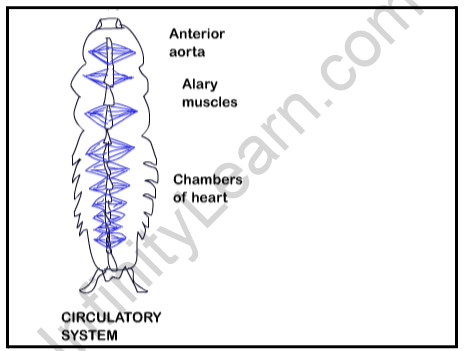Table of Contents

It is probably the most disgusting insect ever. But the fact is that cockroaches lived on earth 300 million years ago and still exist on earth. Read on to find out more about external morphology and internal anatomy as part of the phylum Arthropoda. The most common term is scientifically known as Periplaneta americana.
Circulatory system:
Heart and Aorta:
The heart end is a long contractor, a small tube lying in the middle of the middle thoracic spine and abdomen below the terga. The heart is closed in the pericardial sinus, its wall with the alary muscles, and the posterior diaphragm.
The heart wall is made up of connective tissue from the outside and cells of the central muscle. The heart cavity is covered by a sarcolemma of medial muscle cells. The heart consists of thirteen well-shaped chambers is arranged in sections, each connecting with a valve opening with the one in front of it.
The back of each room has a few minute openings in the back and valves called Ostia, which allow blood to flow from the pericardium to the heart only and not to the back. At each stage, the heart sends a pair of pre-existing arteries.
The heart is closed at the back but progresses like a short and narrow tube without Ostia called the aorta. These aorta and lateral arteries eventually open within the hemocoel space.
Hemocoel:
The endothelial cell is not a real coelom but a blood-containing hemocoel (hemolymph).
Flowing Liquid in Cockroach:
Hemolymph:
In a cockroach, the circulating fluid does not always flow into the vessels, but rather comes into direct contact with the tissues while flowing into the haemocoel.
So ‘blood’ ends up in the blood and lymph and is therefore called hemolymph. It is colorless since it has no hemoglobin in the respiratory pigment and does not participate in respiration. It contains plasma of clear fluids in which there are nucleated cells or hemocytes fixed.
Plasma contains various inorganic ions such as sodium, potassium, calcium; organic compounds such as citrate; amino acids namely. alanine, cystine, glycine, tyrosine, valine, etc.; enzymes such as chitinase and glucosidase; carbohydrates; lipids, and uric acid.
Hemocytes:
The formation and function of hepatocytes in various insects, including cockroaches, have been reviewed by various staff members.
However, the following hemocytes are usually present in the cockroach hemolymph.
- Prohaemocytes: The small circular cells have a large nucleus and a thin agranular cytoplasm. These cells divide to produce other types of hemocytes.
- Plasmocytes: Large amoeboid cells have pseudopodia, a large nucleus, and a large mass of granular cytoplasm.
- Granulocytes: Small to large cells have a granular cytoplasm.
- Cystocele/Coagulocyte: Cells have a small nucleus and a pale hyaline cytoplasm with black granules. The total number of cells in the adult Periplaneta adult hemolymph is estimated at 15,00,000 although the number apparently depends on the hemolymph volume of approximately 15.7-17.5 percent of body weight. Hemocytes play an important role in the physiology and survival of cockroaches.
The contraction of the alary muscles increases the pericardial space so that the hemolymph can flow into it from the perivisceral waist. When the laryngeal muscles relax, the hemolymph is forced into the heart. As the heart relaxes during diastole muscle stiffness stretches the walls of the heart so that the hemolymph can flow to the organs; in front of the head.
It then passes back from the hemocoel of the head to that of the thoracic and abdomen and into the pericardium. In addition to the alary muscles, access to the spinal diaphragm also contributes to the rapid circulation of the hemolymph. The heart beats at a rate of 100-200 per minute at 27 ° C. The complete cycle of hemolymph circulation in the body takes 20-30 minutes.
Also read: Important Topic Of Biology: Animal Cell
FAQs
It ends up being an insect because it has _________.
Cockroaches are the orderly Blattodea insect, sometimes called Blattaria, about 30 of the 4,600 species associated with human habitats. They have six legs. About four species are best known as insects. Cockroaches live in various parts of the world. Insect species adapt to a wide range of conditions but prefer warmer climates. Many tropical species prefer even the warmer climate. The cockroaches mostly fly at night and will flee when exposed to light.
Describe the structure of the whole.
Cockroaches have long horns that help them detect odors and vibrations. The horns are attached to the head, which includes the brain, strong oral components for scrubbing and chewing food, and mixed eyes. They do not see well and do not like the light. Behind the head comes the thorax. It includes three pairs of legs - cockroaches with six legs in total - and two pairs of wings. There is a plate behind the head called the pronotum. Older cockroaches have wings. The abdomen contains the reproductive organs. At the back of the abdomen are two short sections called the cerci. They act as hind limbs and are attached to the roach's legs by the abdominal nerve ganglia. This allows their legs to start moving when a vibration is heard, usually before their brains process a threat.
Name the physical differences of the whole.
The whole body is divided into three stages: the head, thoracic, and abdomen. The head has compact eyes, horns, and parts of the mouth. The thorax has moving legs and wings. The stomach has anal cerci.
Question: It ends up being a male and female animal.
- True
- False
Answer: Anthrax is an insect of the phylum Arthropoda. It is thought to have existed more than 320 million years ago, in the Carboniferous period. They are unmarried animals, with both male and female organs present in a wide variety of living things. One end has male genitals or female genitals. So, the correct answer is ‘False.’








